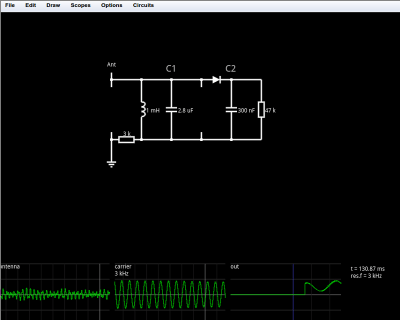[Flownez] sent in a tip that a port of the venerable Falstad circuit simulator is now available that doesn’t require Java (it uses HTML 5). This is a welcome port since some modern browsers (particularly Chrome) make it difficult to run Java applets and prevented the Falstad simulator’s execution.
 Like the original simulator, this one is great to show a classroom circuits and encourage building or studying circuits in the browser. There’s no extra software to install, which is handy for an impromptu demo. Another cool feature is the visualization of current flow as animated dots. The dots move in the direction of the current flow and the speed of motion is proportional to the amount of current. Watching a capacitor charge with the moving dots is very illustrative. You can also view data in a scope format or hover the mouse over things to read their values.
Like the original simulator, this one is great to show a classroom circuits and encourage building or studying circuits in the browser. There’s no extra software to install, which is handy for an impromptu demo. Another cool feature is the visualization of current flow as animated dots. The dots move in the direction of the current flow and the speed of motion is proportional to the amount of current. Watching a capacitor charge with the moving dots is very illustrative. You can also view data in a scope format or hover the mouse over things to read their values.
You can open a blank circuit and add quite a few components (use the right click button on your mouse or the menu to add components and wires). However, you can also pick from a number of predefined circuits ranging from the simple (a voltage divider, for example) to the illustrative (a PLL frequency doubler comes to mind). There’s even an AM radio (see below) that you can tune to find several “stations” by varying the tuning capacitor’s value. Circuit elements include many types of analog and digital components.
The simulator probably won’t lure you away from LTSpice, and there are other Web-based alternatives like TINACloud and others, but the simplicity of the Falstad simulator (and the new HTML 5 port) along with its library of illustrative circuits makes this a site you’ll want to bookmark.
[Thanks Flownez]
















Most excellent, love it :)
I mirrored his fantastically easy to understand simulator, because he makes it available at GitHub and I wanted to showcase many of my circuits all in one place whose development his simulator has made possible. Yeah, I’ve used LTSpice on occasion and Micro Cap, v.11, but either they’re more rigid in disallowing surges or else they don’t allow surge oriented circuits at all, respectively. So, I prefer to use Paul’s.
http://vinyasi.info/ne
I am a huge fan of Falstad’s simulator… it may not do everything or model specific parts, but as a general teaching tool it is great. The HTML5 version is excellent – I have been downloading the Java files and running locally as a Swing app rather than running in an applet, but this makes things even easier.
Cheers
Absolutely! I spend a lot of time talking at schools and the simulator is a fantastic tool to show and to let them play with too.
When I saw the photo I thought it was the one from falstad.
Falstad’s simulator is pure love.
While the HTML5 version is fine for running on a browser, I still use the Java applet for that greater fps and pixely feel.
I’ve actually built it from source https://github.com/sharpie7/circuitjs1 via google plugin. I can now include it on my site. I will try to integrate it into moodle as well
Hi halherta,
can you share your built as I’m not able to build it (dependencies/libraries/framework I’m not acustomished with) ?
Most awesome project I’ve seen in a while! Keep up the good work!
This is fantastic! Thanks for posting this!!!
This is amazing. I’m currently in Physics 2 learning about AC, inductors, and capacitors. This is more helpful than the textbook.
Falstad was the first to come up with this idea of visualizing voltage and current. He was nice enough to open-source it too. I see many people blatantly copying it without giving any credit. I can list many projects including this one which use the same idea and probably the same simulation engine:
iCircuit — iOS
Everycircuit — iOS and android
This project — Browser
Many others I don’t remember right away
Regards,
Vikas
“File” > “About”
> Circuit Simulator version 1.0.1.
> Original by Paul Falstad.
> http://www.falstad.com/
>JavaScript conversion by Iain Sharp.
>http://lushprojects.com/
Ive wanted to play with one of these since like 3rd grade. Can’t edit components on android. Is there a good app?
Derp. Apparently I’ve had this window in the background since before the previous comment.
This is pretty cool.